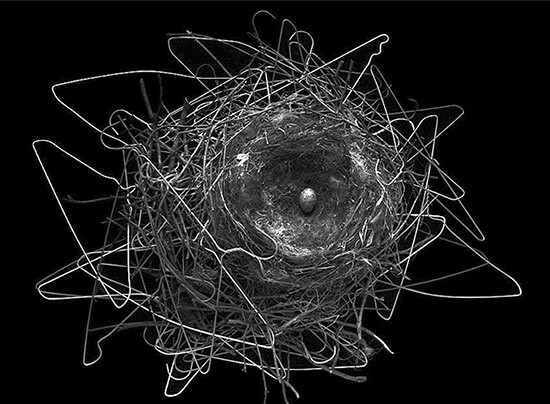It is probably a mistake to elevate those attributes of the homo sapiens nervous system that long for the right answer, the unified field, the elementary particle, or the universal truth. These beliefs are present not only in formalized philosophies, religions and political regimes of the human, but at the heart of the human’s daily activities. Some cerebral constructs—the most immaterial and ephemeral of all the body’s inventions—ossify into cast-iron closed loops of logical thinking that demand to be “the one and only.” A dictator, professor, spiritual leader, parent or co-worker all practice daily meditations or tireless litigations about the reasons why they are right. Almost everything else in the soft assemblies of most organisms works by endless iteration, multiplication, or trial and error. Yet this stray symptom of stubborn self-regard holds sway over the entire organism, causing it to constantly circle a very limited repertoire of behaviors. Observing the fact that there do not seem to be other creatures who sit, with fins and flagellates limp, transfixed in thought about something like dialectic and telos, humans even make the mistake of thinking that this restrictive habit of mind is a gift that sets them above the rest.
Since superiority cannot abide contradiction, the whole assembly also often oscillates between a closed loop—the circulation of flattering and compatible evidence—and a binary fight—the vilification of non-conforming evidence. Fighting is essential to be right. There is no growth or ideation without argument or debate. There is no literature without conflict. Bombastic arguments must naturally ask for successive rather than coexistent thoughts or practices. They must wipe away the incumbent and establish the new and transcendent. The root of the problem—the desire to be right—is treated as the progressive answer to the problem. The new right answer kills the old right answer, and the very habits of mind that help to incite violence are deployed in an impossible attempt to alleviate it. Essentially there is very little difference in spirit or intent between an avant-garde of ideas and an avant-garde of combat formation. Whether taking the form of intellectual sparring or all out war, these are the grisly histories of the “humanities.”
True to the disposition of the closed loop, the argument that is inescapable will, structurally, always be correct. In a recent book about winning arguments, a human named Stanley Fish quotes an exchange from Monty Python’s “The Argument Clinic.” Michael Palin, who has come to the clinic to pay for an argument, says, “Argument is an intellectual process. Contradiction is just the automatic gainsaying of anything the other person says.” John Cleese replies, “It is NOT!” Unwittingly adding to the comedy, Fish uses the exchange to prove that he himself was right all along about the ubiquity of argument.1 He and so many others, as if perpetually saying “There you are, you see,” will always be human and always be right. And culture continues to congratulate itself on its ability to debate or deploy the logics of reasonable thinking to arrive at proofs that demonstrate the right answer.


John Cleese, Michael Palin, Terry Gilliam, and Terry Jones strike a pose in April 1976.
Beyond the daily preoccupations of individuals, the loop and the binary are scalable. Whole populations of people and huge territories captivated by some universal belief or totalizing regime of control can move in lock step to demonstrate that they are right. Muscles and fists harden into weapons. Demonstrating all reasonable outcomes of aggression or consumption, statistics, data, or game theory support rationalizing wars and markets. Global infrastructure platforms historically portray themselves as ultimate, transcendent, and redemptive; it was as true for railroads as it is now for digital technologies that treat data as the only information of consequence in a world that is Turing complete. It is not just ISIS teenagers who, gun and sledge hammer in hand, long for their own Caliphate.
From the ancients to the moderns, those who have so suggestively attempted to break the spell of the loop and the binary with other powers of homo sapiens are often drawn back into its vortex. With faith in corporeal agency, polytheism and democracy, the ancients, still often regarded as a pinnacle of culture, offered only a suggestive start in uncovering the organism’s power. Or, to escape the “iron cage” of rationalized culture, we choose an ideology that is even more right. Perhaps a Marxist position will duel with the market until it arrives at a utopian ultimate, one that will fail only because of a lack of purity. Deleuze and Guattari provide another vivid example of philosophers so learned that they are capable of pointing to things outside their philosophy—to animals, everyday practices, or colloquial expressions. “Many people have a tree growing in their heads, but the brain itself is much more a grass than a tree,” they write. Yet in trying to break free, they nevertheless deploy habits of mind that sometimes drift toward monism and binary opposition. “So much getting even, for epistemology is not innocent.”2 And isn’t the loop and binary securely locked in place when an attempt to escape the humanities calls itself “radical” or “post-human?” Again, the logic that humans have prized thrives on it own self-perpetuating negation.
But while difficult to express within rational structures of thought, humans are always escaping the cage and exceeding the bounds of the human. The world is run on irrationality and comedy that often will not compute within our philosophies. Many things change not because of logical proof or a reasonable plan but because of irrational desires, and the most rationalized game theory can be outwitted with a simple series of lies. For philosophers, these powers are often treated like witchcraft or some other unknowable, magical quest, even though they are just another kind of knowledge that is often manifest in ephemeral, even practical, activities. This is the knowledge of use—of “knowing how” in addition to “knowing that.”3 These are the powers of Marx’s “mystical” dancing table that is often believed should be made to stand still. But maybe they are really more like Gabriel Tarde’s social “contagions,” the life blood of economies of exchange. They are persuasions rather than arguments that start nowhere and move across populations. Perhaps many of the world’s most puzzling problems—problems that resist rational explanation—reside in this outlying territory.
The most dangerous human bullies and sociopaths are perhaps so sturdy because they not only have an abiding faith in the loop and the binary, but also a crafty talent for wielding irrationality and fiction. They never tire of a circular argument and engage, almost involuntarily and until their last breath, in a “did-did-not” or “is-is not either” exchange. Not only will they not back down; they are eager to deliver an offensive strike. They are happy in the loop because they are the loop. They are the “one and only,” and any contradiction is not only expelled but also tracked down and destroyed. Still, the most successful bullies also know about the contagion of persuasion and how to manipulate it. They know that telling one lie activates and strengthens rational behavior because it calls on the necessity of rational behavior to sort out and restore truth, yet the presence of many lies begins to build up the Teflon coating on which rationality slips and slides. This is the power of religious leaders, politicians, and celebrities. Their siren song can cause people to stand in single file to go over a cliff. Like a drunk who tries especially hard to walk as if sober and composed, as each follower falls, they will tell you that they are more right, even more rational, than others not in line. Acting as if they alone have access to the facts, the followers condescend to litigate the details of their project for the less reasonable or the ill-informed. The familiar human desire to occupy a superior platform perfectly camouflages the power to seduce and hustle. So, armed only with rationality or a desire to win the argument, it is nearly impossible to derail or interrupt this seduction or oppression, whether from a schoolyard menace, a petty administrator or an authoritarian leader of our modern “democracies.”


The fibonacci ratio applied to Donald Trump’s haircut.
Opposition to a bully is doomed to circle the human tautology about being right, but offering an expanded repertoire of behaviors is a power that can baffle philosophies by exceeding competition, rationality and righteous self-regard. These powers are so familiar that they may be almost imperceptible, or perhaps they are only difficult to express within familiar forms of discourse. In order to exist beyond the human they include the human rather than negate it. They are “more than human” and sometimes beyond the skin and the self.4 While often treated as paranormal to the reasonable human, everyone possesses the capacity to exercise these powers—to wander away from dominant constructs and outwit their persistent violence.
Design is an excellent arena in which to observe the relentlessly human as well as the possibilities of the more than human. Within the narrow framework of the human, design can be about the total extension of rationality into the surrounding environment with universal systems of proportion or geometry that make claims to “natural laws.” While it is easy to think of a historical Gesamtkunstwerk reflecting these design ideologies, contemporary digital environments are also locked around totalizing dreams and the very limited powers of a nervous system oversaturated with optics and default sexuality. But design can also be about extending other powers of that nervous system. There are so many underexploited faculties of voice, skin, skeleton, muscles in interplay with other solids, photons, and waves. The more than human doesn’t negate human design; it only multiplies those designs in a larger field so that there are always many instead of only one.


Coat hangers used to build a crow’s nest. Photo: Yosuke Kashiwakura
Beyond the design of things is the design of the medium in which they are suspended, and beyond the design of a totalizing medium is the design of an iterative medium. The right answer is doomed to be right only for an instant before its superiority is challenged. But just as navigating a river is indeterminate to be practical, time-released designs offer an unfolding, indeterminate set of changes that continually redirect away from the loop and the binary. That indeterminacy is not marginal or weak—just agile enough to respond to the moment when it is out-maneuvered. So in addition to the design of master plans we should see the design of reagents, mixtures, interdependencies, chemistries, chain reactions and ratchets. These designs offer no correct answer or homeostatic balance, but if there are dispositions of violence embodied in space, are there not also dispositions that ease or neutralize tension and violence? The documents that architects present in the future might not be snapshots of perfect moments, but specifications for linkage and interdependency that remain in place to counterbalance and imbalance each other.
Designing the more than human is a little bit like playing pool. The balls on the table are a topology, a network of sequenced relationships. There is no single target at which to aim but rather a stretchy network of hard and absorptive surfaces. The player who sees only one fixed sequence will sink fewer balls, reduce the potentials of the table, and lose. Rarely are the cue ball and its target geometrically aligned with the hole, so the majority of shots involve the expertise of indirect contact and ricochet. The game is played like a chain reaction with multiple branching possibilities that change after every shot. And yet with every shot, the most constructive thing that can be done is to increase the chances for more shots—generate more branches in the network of possibilities, more information. There is no need to call each shot, and it is better to keep the spectators guessing. Then there is also the matter of touch, which can’t easily be described, but only understood by doing it. Pool is only a reminder of all the things that can change when a body, with all of its sentience and force fields, brushes against the air. It can be a matter of deliberate speed and impact, coming from hands through the cue stick and out to the ball. But sometimes it is a matter of English—the spin placed on the cue ball that is later transferred to another. English is an advanced technique that can’t be predicted, but it can be exploited. It is less about the intention of the shooter and more about something between the moving solids outside the human skin. The player who can continue to set up potentials and options can play the table longer. It is something like being too smart to be right.
Stanley Fish, Winning Arguments: What Works and Doesn’t Work in Politics, the Bedroom, the Courtroom, and the Classroom (New York: Harper Collins, 2016).
Gilles Deleuze and Felix Guattari, A Thousand Plateaus: Capitalism and Schizophrenia (Minneapolis: University of Minnesota Press, 1987), 15 & 53.
Gilbert Ryle, The Concept of Mind (Chicago: University of Chicago Press, 1949), 27–33.
Jane Bennett, “Systems and Things: a response to Graham Harman and Timothy Morton,” New Literary History 34, 2 (Spring 2013): 225.
Superhumanity is a project by e-flux Architecture at the 3rd Istanbul Design Biennial, produced in cooperation with the Istanbul Design Biennial, the National Museum of Modern and Contemporary Art, Korea, the Govett-Brewster Art Gallery, New Zealand, and the Ernst Schering Foundation.
Category
Subject
Superhumanity, a project by e-flux Architecture at the 3rd Istanbul Design Biennial, is produced in cooperation with the Istanbul Design Biennial, the National Museum of Modern and Contemporary Art, Korea, the Govett-Brewster Art Gallery, New Zealand, and the Ernst Schering Foundation.






























































